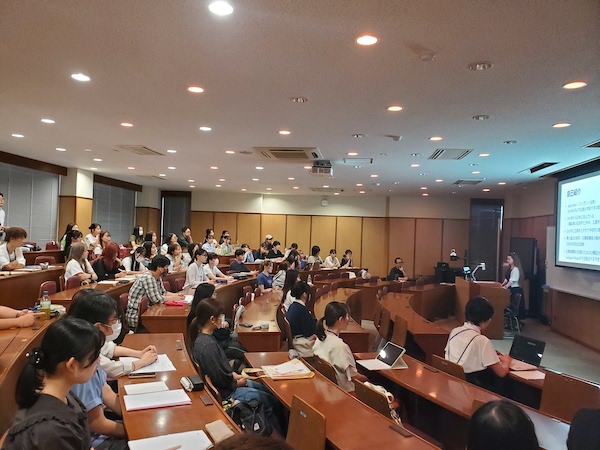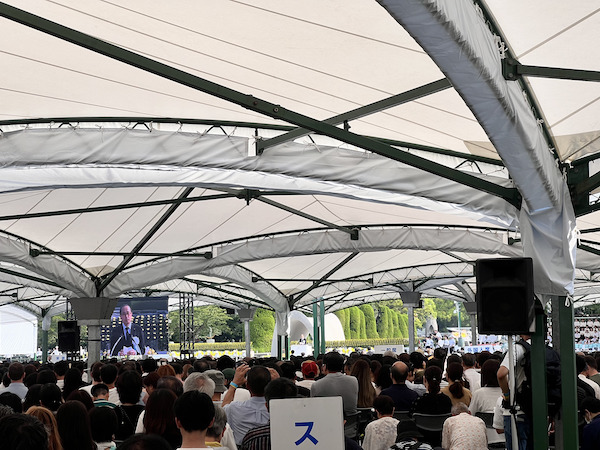The “Hiroshima and Peace” Course: A Shared Journey of Learning and Reflection 「ヒロシマと平和」:ともに学び、ともに考える平和の旅
2025.07.03 授業紹介
In this article, Agota Duró sensei will introduce the course Hiroshima and Peace 「ヒロシマと平和」, which she has been teaching since April 2024. Hiroshima Jogakuin University launched this intensive Japanese-language peace course in 2004 for students from Kwansei Gakuin University. Later, students from Hiroshima Jogakuin University also began participating. The program offers a unique opportunity for students from both institutions to deepen their understanding of the history and legacy of Hiroshima as a city of peace.(この記事では、国際英語学科の教員Agota Duró先生が2024年4月から担当する「ヒロシマと平和」という講座を紹介します。本学は2004年に関西学院大学の学生を対象に日本語で行う平和講座を開講し、その後、広島女学院大学の学生も参加するようになりました。両大学の学生にとって、広島の歴史を深く学ぶ貴重な機会となっています。)
Currently, there are two pre-study sessions in May and July, which are held in-person for Jogakuin students and online for Kwansei Gakuin students. The pre-study sessions provide students with essential background knowledge, including Hiroshima’s pre-war history, Japan’s role as both victim and perpetrator in World War II, the atomic bombings of Hiroshima and Nagasaki, global nuclear testing during the Cold War, the rise of peace movements advocating for the abolition of nuclear weapons, and the ongoing threat that nuclear weapons pose to humanity. The lectures are followed by discussion sessions between Hiroshima Jogakuin and Kwansei Gakuin University students. This is an invaluable occasion for students of the two universities to exchange their opinions on peace and the tragedy of the atomic bombings from a humanitarian perspective.(事前学習が5月と7月に行われ、広島女学院大学の学生は対面、関西学院大学の学生はオンラインで参加します。内容は多岐に渡り、広島の戦前から現在までの広島・長崎の原爆投下、冷戦期をめぐる歴史や、核兵器廃絶を求める平和運動、現在の核の脅威などを学びます。事前学修からグループワークを通して意見交換を行います。)
The most important part of the course is the intensive summer program, typically held from August 4 to August 8. During this period, students from Kwansei Gakuin University visit Hiroshima to join their counterparts from Hiroshima Jogakuin University for a week of joint lectures, workshops, fieldwork, and peace-related events. A central component is their participation in the annual Peace Memorial Ceremony at the Hiroshima Peace Memorial Park on August 6. Students also attend the memorial service at Hiroshima Jogakuin Junior and Senior High School, where 350 students, teachers, and staff lost their lives in the atomic bombing. In 2024, one of the invited lecturers was former Hiroshima mayor Hiraoka Takashi, who spoke about his wartime experience as a child and his postwar career as a journalist with the Chugoku Shimbun. Mr. Hiraoka was one of the first Japanese to raise awareness about the neglect of A-bomb survivors in South Korea and took active steps to support them. The intensive summer program concludes with group presentations, where students share what they have learned, reflect on their fieldwork and questionnaire activities, and discuss their evolving views on peace. Finally, each student submits a research paper, offering personal reflections on how the course has influenced or reshaped their understanding of peace and nuclear history.(8月4日から8日まで広島で行われる夏期プログラムでは、関西学院大学の学生が広島を訪れ、広島女学院大学の学生と一緒に講義、ワークショップ、フィールドワーク、平和関連のイベントに参加します。平和記念式典はもちろん、原爆で350人の生徒と教職員が犠牲となった広島女学院中学高等学校の慰霊祭にも出席します。2024年には特別講師として元広島市長の平岡敬氏をお招きし、戦時中の子ども時代の体験や戦後の中国新聞記者としての活動などについてお話しくださいました。夏期プログラムの最後には、グループ発表で学びやフィールドワーク、アンケート調査の結果を共有し、平和に対する考えの変化などについて議論します。)

Specializing in Peace Studies and the history of the atomic bombings, I had the pleasure of leading the program for the first time last year, and I am also teaching the course to students from both universities this semester. Although I was initially a bit concerned about how it would turn out, the program was fortunately a success, thanks to the cooperation of two professors from Kwansei Gakuin University and the administrative staff at both institutions. It was inspiring to observe how formative the experience was for many of the student participants. The collaborative learning between students from different universities allowed them to encounter diverse perspectives and academic approaches. AT from the Nutrition Department shared, “Through this course, I was able to reflect once again on ‘Hiroshima’ and ‘peace.’ Working in groups with students from Kwansei Gakuin University allowed me to hear a variety of opinions and perspectives, which helped broaden my own viewpoint. Taking this course gave me the opportunity to think about peace from the perspective of a university student, making it a deeply meaningful learning experience.” Similarly, KA from the Department of Child Education noted that what is considered common knowledge in Hiroshima may not be known in other regions, and that participating in group discussions and presentations with students from the Kansai region helped her gain new insights.(関西学院大学の2人の教授や両校の職員の協力のもと行われる異なる大学の学生同士の協働学習により、受講生は多様な視点や学問のアプローチに触れることができます。昨年プログラムに参加した2人の学生の感想をご紹介します。管理栄養学科のATさんは、「この授業を通して、改めて「ヒロシマ」と「平和」について考えることが出来ました。関西学院大学の学生とグループワークを行うことによって、様々な意見や考え方を知ることができ、大学生としての視点から平和について考え、深い学びとなりました」と感想を述べています。児童教育学科のKAさんは、ヒロシマに生きる私たちと関西の人の知識にはかなり差があり、知っていることが普通という訳ではないと気づいたそうです。

Some may wonder why it is necessary to study peace. When we think of the horrors of World War II, which ended 80 years ago, the Holocaust and the atomic bombings of Hiroshima and Nagasaki inevitably come to mind. Learning about these events can be emotionally challenging, especially for young people, but I believe it is essential to gain a deep understanding of the past and the factors that led to the deaths of millions during the most destructive war in human history. It is our responsibility—those of us living today—to learn from these tragedies and ensure that such horrors are never repeated. There must never be another Hitler, nor any racial ideology justifying genocide, nor another atomic bombing of cities inhabited by innocent civilians.(第二次世界大戦のホロコーストや広島・長崎の原爆投下といった出来事を学ぶことは、特に若い世代にとって精神的に難しいことですが、人類史上最も破壊的な戦争の原因を深く理解することは重要です。こうした学びを通して、私たち現代に生きる者には、同じような惨事を繰り返さないよう努める責任があるからです。)
With this in mind, we must work to create and sustain a peaceful world and pass on the importance of peace to future generations. We have a duty to remember the victims and ensure their sacrifices are not forgotten. By keeping their stories alive, we can contribute to a more peaceful future and prevent the repetition of past atrocities. Education plays a vital role in shaping young minds, and teaching them about the devastating realities of war is more important than ever. Through the Hiroshima and Peace course, I hope to continue sharing this message with more students. By encouraging mutual learning and discussion, I am convinced that students can expand their awareness of peace and take meaningful steps—however small—toward creating a more peaceful and compassionate world around them.(平和な世界を築き、維持し、次の世代へと平和の大切さを伝え、戦争で犠牲となった人々への思いを風化させないことは、現在に生きる世代の責務です。戦争の犠牲者の物語を語り継ぐことで、過去の惨劇の再発を防ぎ、より平和な未来に貢献できます。教育には、若者の心を育み、戦争の悲惨な現実を教えることが求められています。「ヒロシマと平和」講座で、学生同士の相互学習と対話を促すことで、こうしたメッセージをより多くの学生に伝えていきたいと考えています。)







